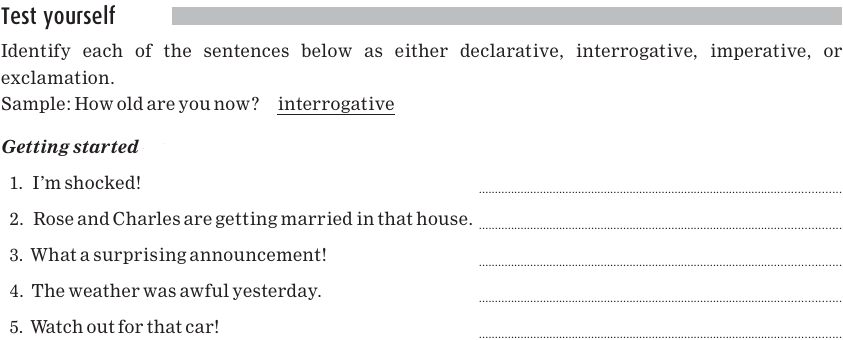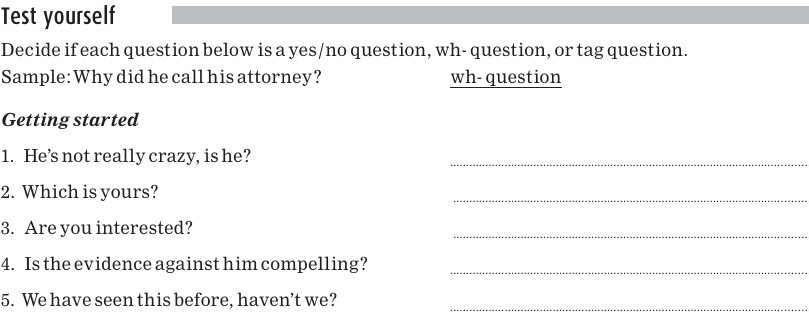
THE FUNCTIONS OF SENTENCES Identifying sentences by function
 المؤلف:
EVELYNP.ALTENBERG & ROBERTM.VAGO
المؤلف:
EVELYNP.ALTENBERG & ROBERTM.VAGO
 المصدر:
English Grammar Understanding the basics
المصدر:
English Grammar Understanding the basics
 الجزء والصفحة:
P203-C15
الجزء والصفحة:
P203-C15
 2025-11-17
2025-11-17
 45
45
THE FUNCTIONS OF SENTENCES
Identifying sentences by function
One way that a sentence can be described is according to the job that it’s doing in a conversation. Compare these sentences:
1.Thatclownwasfunny.
2. Is she a physician?
3. Please wash the dishes.
4.What an exciting movie!
You know that sentence 1 is making a statement, sentence 2 is asking a question, sentence 3 is giving a command, and sentence 4 is expressing a strong emotion.
Quick tip
Sentences that make a statement are called declaratives; sentences that ask a question are called interrogatives; sentences that give a command are called imperatives; sentences that express strong emotion are called exclamations.
Here are a few more examples:
5. Edward’s parents live on a farm. (declarative)
6.Have you accepted the fact that she’ll never move? (interrogative)
7. Don’t believe a word she says! (imperative)
8.That’s silly! (exclamation)

Answers

Let’s take a closer look at questions:
9. Do you like learning about sentences?
10. What do you like best?
11. You would rather be listening to music, wouldn’t you?
These sentences demonstrate three different kinds of questions. Sentence 9 is an example of a yes/no question, because it can be answered with just a ‘‘yes’’ or ‘‘no.’’ Here are some more yes/no questions:
12. Did you enjoy the music?
13. Is the television working?
14. Are you interested in applying for that job?
Quick tip
A yes/no question is one that can be answered by ‘‘yes’’ or ‘‘no.’’
Sentence 10 is called a wh- question because it begins with a wh- word, or question word.
Quick tip
A wh- question begins with one of the following wh- words (question words): when, where, what, why, which, who, whom, how. Example: Where is the meeting?
Notice that how is a wh- word, even though it doesn’t begin with wh-.
Wh- questions cannot be answered with a ‘‘yes’’ or ‘‘no.’’ Imagine the following bizarre dialogues:
15a. What time is it?
15b. Yes.
16a. Where are you going?
16b. No.
17a. Which dress should I wear?
17b. Yes.
You get the point.
Here are some more examples of wh-questions:
18. Why did they buy that house?
19. When should we meet?
20. How does that work?
The third kind of question, called a tag question, is demonstrated by sentence 11 above.
Here are some more tag questions:
21. He’s having a great time, isn’t he?
22. It rained last night, didn’t it?
23. Mrs. Williams was working hard, wasn’t she?
In tag questions, there’s a regular statement followed by a tag; the tag is underlined in these examples.
Quick tip
A tag question contains a statement followed by a tag, such as, could you? aren’t they? hasn’t he? Example: She is leaving soon, isn’t she?

Answers

 الاكثر قراءة في Grammar
الاكثر قراءة في Grammar
 اخر الاخبار
اخر الاخبار
اخبار العتبة العباسية المقدسة


